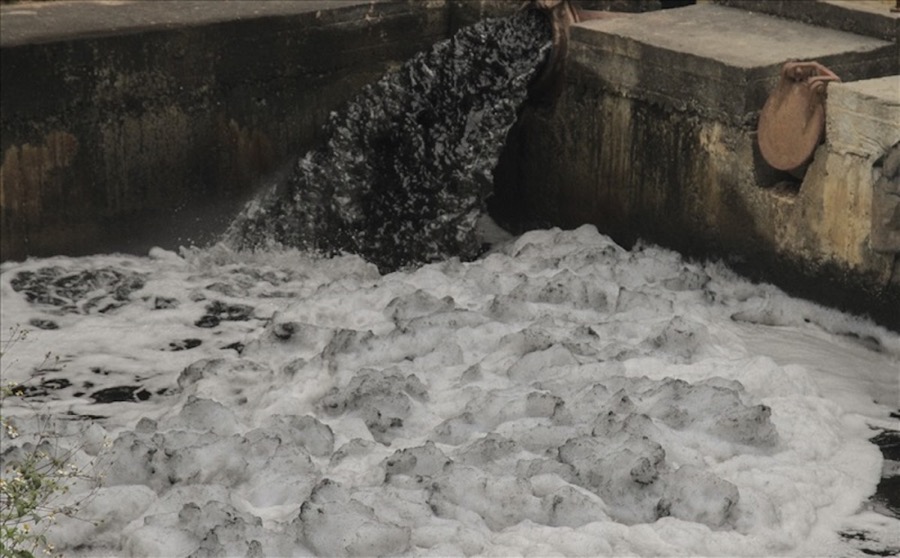During the operation of a wastewater treatment system, the presence of turbidity in the effluent often raises concerns among engineers and businesses. In some cases, this may be a normal phenomenon at certain stages, but it can also be a sign that the system is not operating effectively. Identifying the root cause is key to ensuring the treated water complies with environmental standards and avoiding legal risks.
1. What is turbidity? Is turbidity in treated water good or bad?
Turbidity is an indicator of the presence of suspended solids in water, including sludge particles, microorganisms, colloids, or fine mineral matter. It is one of the important parameters for assessing the quality of treated effluent, as it affects both aesthetics and compliance with discharge standards.
In certain cases, effluent may still appear slightly turbid even when the system is operating normally. Common causes include micro air bubbles, fine minerals, or residual coagulants that haven’t fully settled—these are typically normal and stabilize over time with proper flow regulation. If other indicators such as COD, TSS, or coliform levels are within acceptable ranges, this level of turbidity may be considered acceptable.
However, if turbidity persists, increases significantly, or is accompanied by odors or unusual colors, it likely indicates inadequate treatment. Common causes include ineffective coagulation–flocculation processes, weak biological sludge, uneven flow distribution, or inefficient filtration. In such cases, detailed inspections are needed to avoid exceeding QCVN standards and causing environmental or legal consequences.

Understanding turbidity in wastewater: A warning sign for your system?
2. Cases where turbid effluent poses risks
2.1 Ineffective coagulation–flocculation process
The efficiency of coagulation–flocculation largely depends on operational factors such as chemical dosage, mixing conditions, and reaction time. Incorrect dosing of PAC, alum, or polymer—too little leads to ineffective floc formation, while too much can cause floc breakage—results in turbid effluent. Additionally, if mixing devices operate at improper speeds, they may disrupt floc formation: excessive mixing breaks flocs apart, while insufficient mixing cannot generate strong bonds. If water does not remain in the reaction tank long enough, the coagulation process is incomplete, and fine particles won’t settle properly.
2.2 High post-treatment TSS, SS, or colloids
Another common reason for turbid effluent is incomplete removal of suspended solids during treatment. This may result from unstable activated sludge, low microbial density, or weak floc structure that lacks the weight to settle effectively. Moreover, ultra-fine colloids under 1 micron in size cannot be removed by conventional sedimentation and may pass through secondary clarifiers or filters if the system lacks advanced treatment technologies.
2.3 Rising biological sludge
Bulking or foaming in the clarifier often causes sludge to rise to the surface instead of settling, leading to sludge being carried over with the effluent and increasing turbidity. Sudden changes in flow rate—either rapid increases or abnormal reductions—can disturb flow patterns in the clarifier, resuspending settled sludge or flushing out immature flocs, thus lowering effluent clarity.
2.4 Sub-optimized treatment systems
Some wastewater systems may show turbid effluent even under normal operation due to uncontrolled variables. For instance, a sudden increase in influent load without corresponding adjustments in flow rate, chemical dosing, or retention time will reduce solid removal efficiency. Additionally, without automatic monitoring systems like TSS, pH, DO, or NTU sensors, operators may not detect small but impactful anomalies in time. Relying on visual assessment alone may lead to misjudgment, as water may appear clear but still contain excessive fine particles.

Common causes of turbid treated wastewater
3. Methods to assess and address turbidity issues
-
Analyze technical parameters of the effluent such as turbidity (NTU), suspended solids (SS), total suspended solids (TSS), pH, activated sludge concentration (MLSS, MLVSS), and sludge volume index (SV30) to pinpoint the problematic stage in the process.
-
Review each treatment stage—including coagulation tank, reaction tank, clarifier, mixing systems, and filtration units (if applicable)—to detect abnormalities or underperforming equipment.
-
Adjust operations and chemical dosing by optimizing PAC or polymer levels, fine-tuning pH, and modifying retention times in treatment tanks as needed.
-
Maintain or replace filtration media, such as changing filter sand, activated carbon, or membranes when these materials become clogged or lose effectiveness over time.
Turbidity in effluent is a critical yet often underestimated indicator when judged solely by visual inspection or incomplete data. Persistent turbidity—even when the system appears to function properly—often stems from underlying issues such as poor coagulation performance, unstable biological sludge, inefficient filtration, or lack of continuous monitoring. To resolve such issues thoroughly, operators must combine regular monitoring, in-depth technical analysis, and flexible adjustments to operating parameters. For complex cases, it is advisable to consult reputable experts such as Đại Nam—an experienced provider in designing, upgrading, and optimizing wastewater treatment systems—for effective and sustainable solutions.

